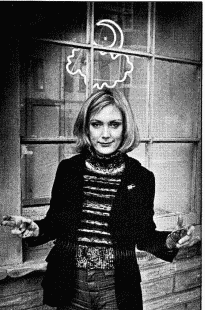|
Anda Korsts
 Former
radio newsperson Anda Korsts organized Videopolis, a "community video
access project," early this year. It's a non-profit, tax-exempt
corporation designed to make sure that Chicago appreciates the potential
and explores the possibilities of half-inch tape before cable arrives. Former
radio newsperson Anda Korsts organized Videopolis, a "community video
access project," early this year. It's a non-profit, tax-exempt
corporation designed to make sure that Chicago appreciates the potential
and explores the possibilities of half-inch tape before cable arrives.
If Videopolis is any indication, Anda has a
great future in underground TV. As Ken Englund of the Illinois Arts
Council staff puts it "Nothing gets in her way!" Her ability and
aggressiveness has enable her to involve organizations as diverse as the
Arts Council, the North Lawndale Economic Development Corporation, and the
Latvian magazine Mazputnins in the project.
In Anda's words, Videopolis is Chicago's first
"comprehensive video project." It provides information about,
and access to, video. Loop College, the
Chicago Board of Education, and Urban Gateways
of Chicago have utilized Anda and her two partners in Videopolis, Lilly
Ollinger and Jack McFadden, to train people in the use of video equipment
and to study the feasibility of using video as an adjunct to their
programs.
The group's more specific focus for this year
is experimentation with five uses of tape: education, community
organization, arts documentation, historical documentation, and archiving.
Because it's the first group in Chicago
organized to meet the need for various kinds of
experimentation, Videopolis has formed associations with some of the
city's most vital institutions: It is investigating tape's community
organization potential with the Citizens Action Program and documenting
the history of Hull House. With Studs Terkel, Videopolis is studying the
possibility of putting books like Division Street: America and Hard Times
on videotape.
And Videopolis has accomplished some firsts.
In the area of arts documentation, it has been developing a series of
programs about the "Chicago School" of artists, the first
significant effort to document these artists and their work. Videopolis
helps each artist to produce his own tape. The initial one-hour tape was
shot in Ed Paschke's home. Videopolis has also preserved some of the
Lincoln Avenue theater scene for posterity by taping the Organic Theater's
Warp and well as Turds in Hell, Muzeeka, and Saved at the Kingston Mines
Theater.
But these are only a few of Videopolis's
liaisons in the Chicago community. It's constantly working to accumulate
more, in Chicago and around the country. Last year Anda attended most of
the major gatherings on cable TV and alternative media. Videopolis
maintains extensive print and tape libraries, circulates a newsletter, and
sponsors regular tape showings.
The basic funding of Videopolis -- $23,000 for
one year -- comes from the Arts Council, the Wieboldt Foundation,
and the University of Illinois at Chicago Circle. Although it would pay
for only one hour-long filmed documentary at Channel 11, the $23,000, plus
about $2,000 from organizations given access to Videopolis, will pay for
equipment, salaries, tape, and other expenses for one year. Videopolis is
a special program in Circle's College of Urban Studies (the University's
coordinator is veteran Chicago filmmaker Jerry Temaner), which status
entitles it to the use of sophisticated editing facilities and an
institutional framework for the distribution of videotapes.
tour years ago, Anda Korsts covered the City
Hall beat for WBBM Radio. She didn't like it, with one exception.
"The Convention in '68 was great. But I had my assignment. I realized
when I was done that I knew almost nothing about the Convention."
After leaving WBBM, she worked with
Michael Sham berg, author of Guerrilla Television (a guide to alternative
video) and a member of Raindance, a pioneering video cooperative in New
York City. Anda and Shamberg had once worked together as reporters at
Chicago's City News Bureau.
Last year Anda was a part of Top Value
Television, a group coordinated by Shamberg which utilized half-inch
equipment to cover both political conventions. Now known as TVTV, it
marketed three tapes of the conventions to several cable companies and
broadcast stations (including Channel 11 in Chicago). Anda appreciated the
ability to shoot a virtually unlimited amount of tape and the lack of
necessity to drag a union crew along with her as she shot. She feels she
knows something about the 1972 conventions. And she learned something
about the nature of the new medium in contrast to broadcast television or
radio: "Because it's inexpensive and mobile, you don't have to plan,
as opposed to the planning that's done in broadcast TV or film. You don't
have to decide on an interpretation before you cover an event. It's closer
to writing. With writing, you take notes about everything. You go back
afterwards and find the quotes or descriptions that are most suggestive.
Similarly, with half-inch tape, you can just keep on taping."
Anda's background is in painting. But she
loves the process of using tape, especially if its allowing her to be
relatively self-sufficient - she can use both camera and microphone at
once. She intends one day to do "very personal video art."
52 HYDE PARKER
|